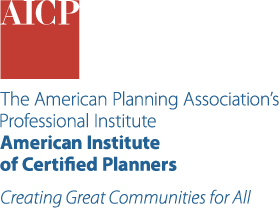Uncovering JAPA
Advancing Equitable Planning Practices

Key Takeaways
- Take opportunities to engage in conversations about equity with elected and appointed officials and clients.
- Implement practices that do not have big price tags but help increase opportunity and access for all.
- Professional associations can foster research that serves the data needs of practitioners in equity planning.
Insight into differing views about equity and barriers to implementing equity policies could help identify tools and resources to advance equity. In "Implementing Equity: Planners, Officials, and Equity Policy" (Journal of the American Planning Association, Vol. 91, No. 3), Carolyn G. Loh, Kristin Caffray, and Kelsey Maas survey planners from the Michigan Association of Planning (MAP) to identify attitudes, barriers, and knowledge gaps about equity planning.
The online survey was fielded in June 2024 to MAP members. The survey was anonymous and dynamically structured with tailored questions based on individual responses. A total of 360 responses were recorded, of which 189 respondents completed the entire survey.
Knowledge and Perceptions
The authors wanted to understand the meaning of equity in planning and the views on equity among the leaders (elected and appointed) working with planners. Fifty-four percent of respondents thought the officials they work with either agree or strongly agree that equity is an important planning priority. In contrast, 32 percent of public-sector planners and 31 percent of private-sector planners rarely or never discussed equity with their officials. The authors point toward a potential hesitancy among planners to discuss equity with the officials they work with, which makes advancing equitable planning policies difficult.
Survey respondents were also asked about equity implementation. Respondents most often cited two types of equity-focused policies: making public participation more inclusive and investment in nonmotorized transportation. The authors speculate that the successful implementation of public participation processes may be because they are most directly under planners' control and are less likely to raise politically thorny questions about resource distribution. The recent availability of federal money for equity policies in nonmotorized transportation and transit projects may have spurred the policies. Nonmotorized interventions, in particular, can be relatively affordable.
Implementation Barriers and Opportunities
Barriers to Implementation
When the survey was fielded in June 2024, barriers to adopting and implementing equitable policies and planning included a lack of funding, a lack of knowledge, and a lack of community support. The highest response, lack of funding, was identified by nearly half of survey respondents, reflecting the competing needs for resources within communities. The authors found that private-sector planners were significantly more likely to report challenges with a lack of community support, a lack of support from officials, and a lack of funding for public participation compared with planners in other sectors.
Opportunities for Increasing Implementation
The authors wanted to uncover what data would support planners' pursuit of equity planning. Survey respondents want more data on the systems and markets influencing affordable and workforce housing. From a set list of options, 61 percent ranked the desire for data about the accessibility of affordable/workforce housing to jobs, and 58 percent selected a 10-year forecast on demand for affordable/workforce housing. Accessibility of affordable/workforce housing to transportation and to shopping rounded out the top selections from respondents.
Current federal cuts and ideological opposition to Diversity, Equity, and Inclusion (DEI) are shaping policy at all levels of government. It may become more difficult to talk explicitly about equity, especially racial equity, about which plans were already often silent. Initiatives that overlap with other community goals, such as health, sustainability, and safety, can be an entry point to equity.
Top image: Photo by iStock/Getty Images Plus/ skynesher
ABOUT THE AUTHOR


